Multi-Stage Production and Process Outsourcing in Automobile-Part Supply Chain Considering a Carbon Tax Strategy Using Sequential Quadratic Optimization Technique
Abstract
1. Introduction
2. Literature Review and Conceptual Framework
3. Mathematical Model
3.1. Assumptions
- The model considered multiple types of items. The production system outsourced operations due to limited constraints. The imperfect products were produced, after which reworking was done and inspection cost was incurred.
- Production and demand rates were constant and known throughout the supply chain. There were no shortages produced in the system (Pa > ∑ Pbi > Pc > D to avoid shortages). The demand rate was equal in all three phases.
- Production and reworking were done in the same manufacturing system at the same production rate. Inventory holding costs were based on the average inventory.
- There was no scrap during the rework process. The rework process was 100% perfect. All products were screened and the screening cost was negligible. Transportation cost was not considered the total cost of the supply chain.
3.2. Decision Variables
- Q, production quantity for manufacturer.
- (Qb1, Qb2, Qb3, …, Qbn) Production Quantity for n outsourcers.
3.3. Notation
3.4. Model Formulation
3.4.1. Cost of Manufacturer
Setup Cost
Manufacturing and Rework Cost
Holding Cost
Transportation Cost
Carbon Tax
Inspection Cost
Total Manufacturing Cost
3.4.2. Total Cost of Outsourcers
3.4.3. Total Cost of the Supply Chain
3.4.4. Constraints
- Production Constraints:
- Demand Constraints:
- Space Constraints:
- To avoid shortage:
4. Methodology
Sequential Quadratic Programming (SQP)
5. Numerical Experiment
5.1. Numerical Example 01
5.2. Numerical Example 02
6. Numerical Results (Case1 & 2) and Managerial Insights
7. Sensitivity Analysis
- The marginal cost had a higher impact on the total cost. Changing the marginal cost by ±50% caused ±29% variation in the total cost.
- A second significant parameter with a high impact on TC was manufacturing cost, Ma. Changing Ma ± 50% varied TC by ±4%. Similarly, inspection cost was the next most significant variable, with a reduction of 3.5% in TC.
- Some variables (MR, Ia, Ic, Ibi, em, ebi, Ma, Mc, and Mbi) had no impact on decision variables, but had a direct impact on the total cost.
- The production rates of manufacturers and outsourcers both had low impacts on the total cost. Comparatively, for any production system, the setup cost and holding cost were the main costs.
- With all costs fixed, increasing these costs had a direct impact on the overall cost. It was observed that the setup cost was more sensitive than the holding cost, meaning that the industry could further reduce overall costs by using initial investment to decrease their setup cost.
- In a traditional production system, inspection cost is controlled through human inspection. An increase in inspection costs could cause an increase in total costs. This could be minimized by replacing physical human inspection with machine inspection
- em and ebi were variables for carbon emission, per unit item of production, for manufacturer and ith outsourcers, respectively. It was noted that em had a high impact on total cost, as compared to ebi. Carbon emission had a direct relationship with total cost, and would thus be of major concern for managers; government policy and customers increasingly demand environmentally friendly products. Therefore, to be competitive in the market, a business must minimize the overall carbon emissions in their supply chain.
- In the case of outsourcers, the most impactful parameters on TC were inspection cost Ib1, manufacturing cost Mb1, carbon emission per unit item eb1, and setup cost Sb1.
- A minor change in these two led to high impacts on the total cost. The other variables also impacted the total cost, albeit minorly. Abrupt changes in the total cost occurred only when the marginal and demand rates were changed slightly. All other variables’ lines merged into each other, showing that there was little or no impact on the percentage of the total cost. The results clearly showed that the marginal rate and demand had a significant impact on output.
- Similarly, the manufacturing cost line had the second-highest impact on total cost; a small change in this was able to change the total cost. The third-highest impact in this category was the inspection cost, which had little impact on the objective function.
8. Conclusions
Author Contributions
Funding
Institutional Review Board Statement
Informed Consent Statement
Data Availability Statement
Acknowledgments
Conflicts of Interest
Appendix A
Appendix A.1. Inventory Diagram of the First Phase of Manufacture
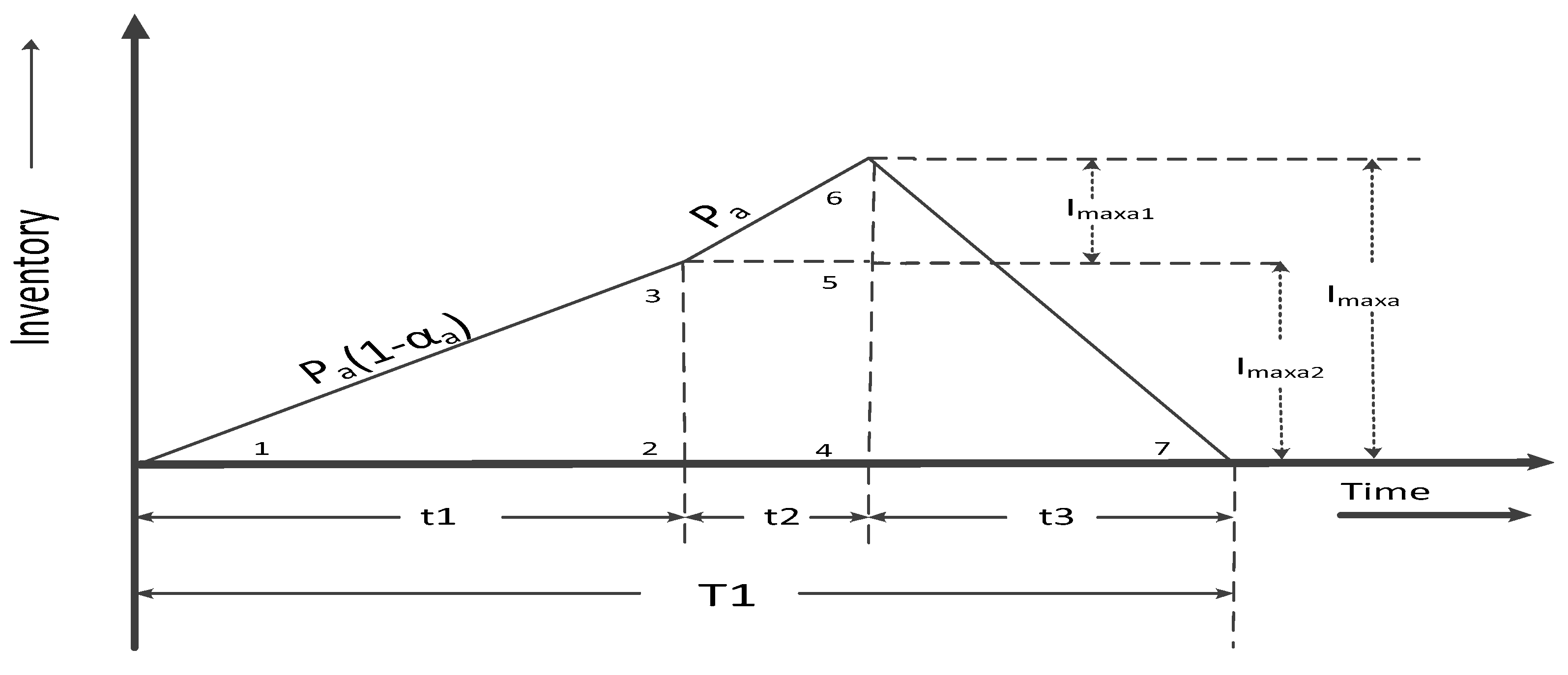
Appendix A.2. Inventory Diagrams of 2nd Phase of Outsourcers
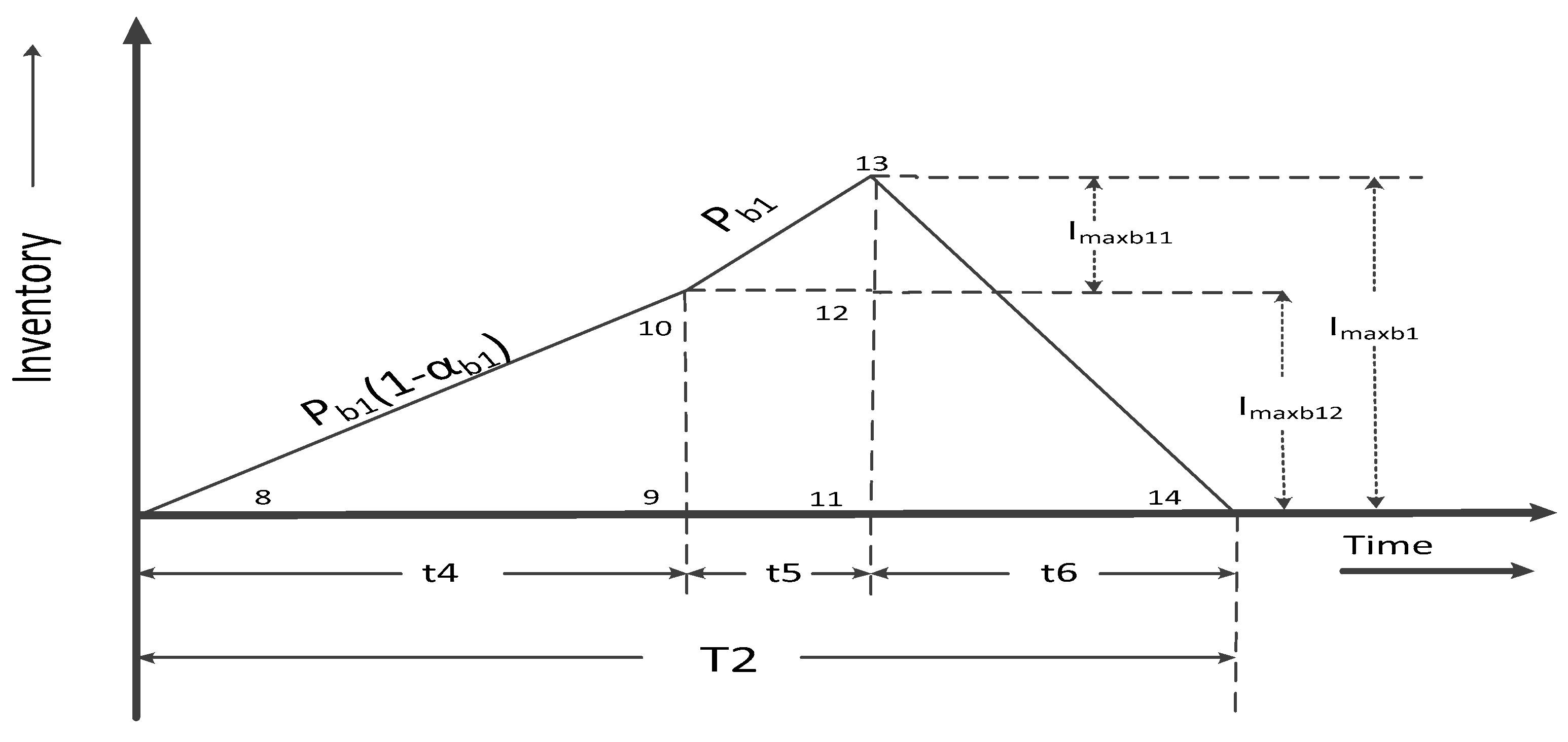
Appendix A.3. Inventory Diagram of 2nd Phase of Outsourcer 2
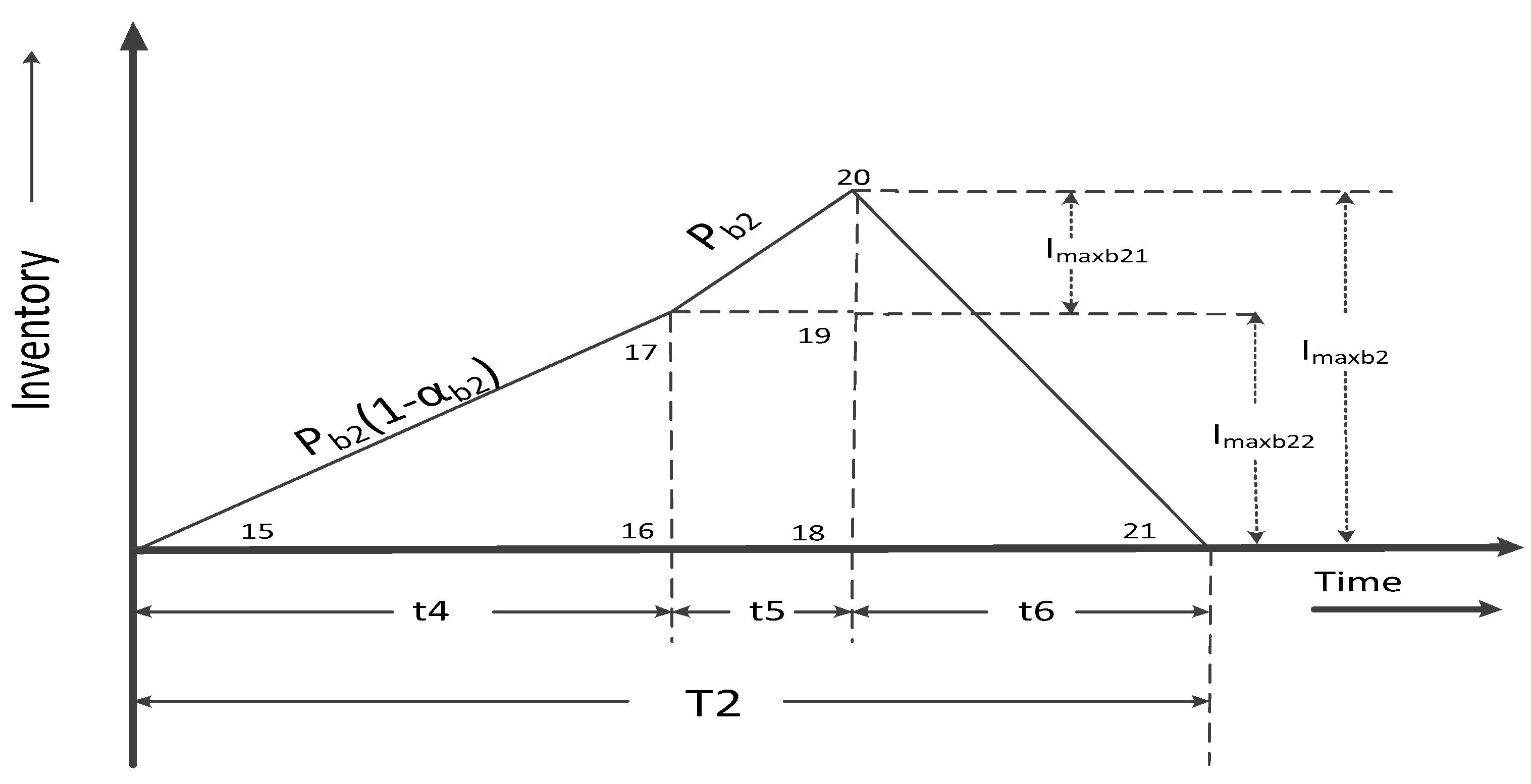
Appendix A.4. Inventory Diagram of 2nd Phase of Outsourcer 3
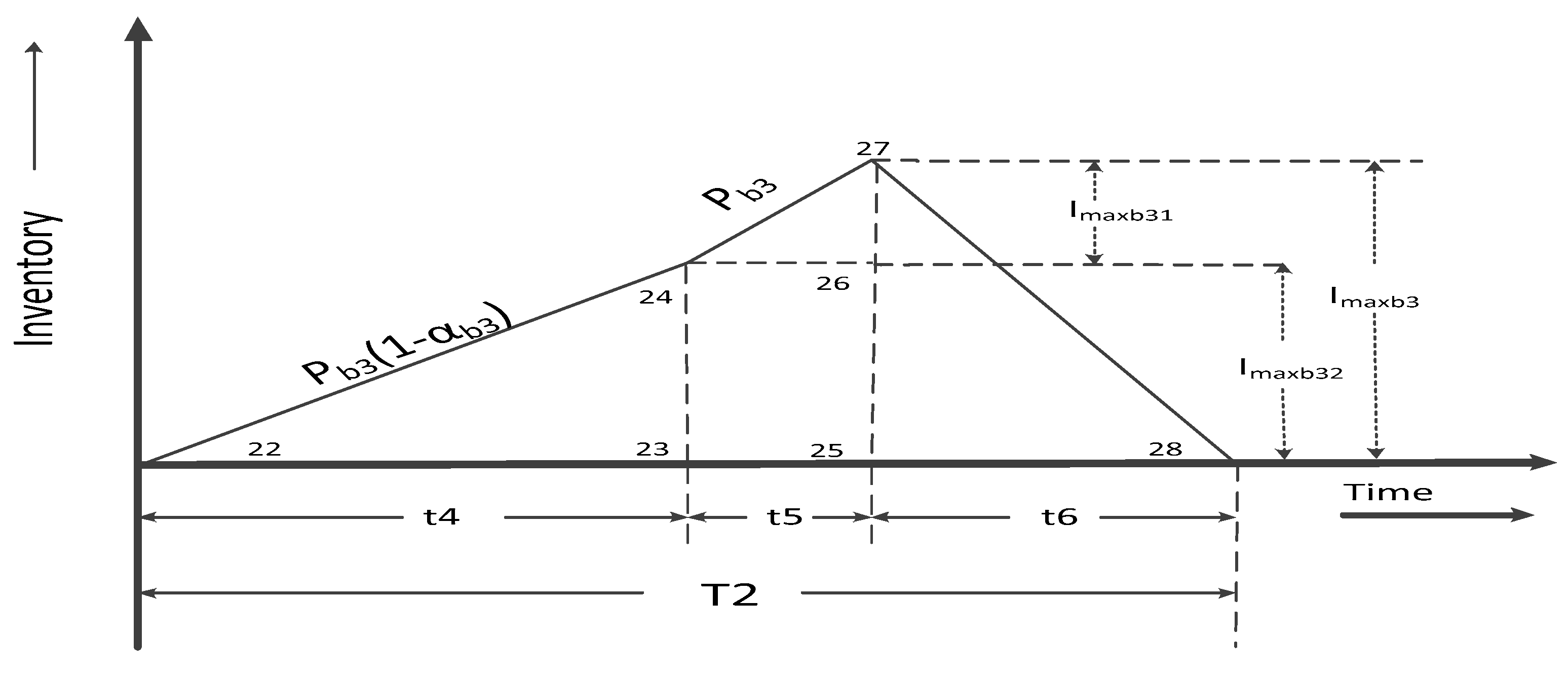
Appendix A.5. Inventory Diagram of 2nd Phase of the ith Outsourcer
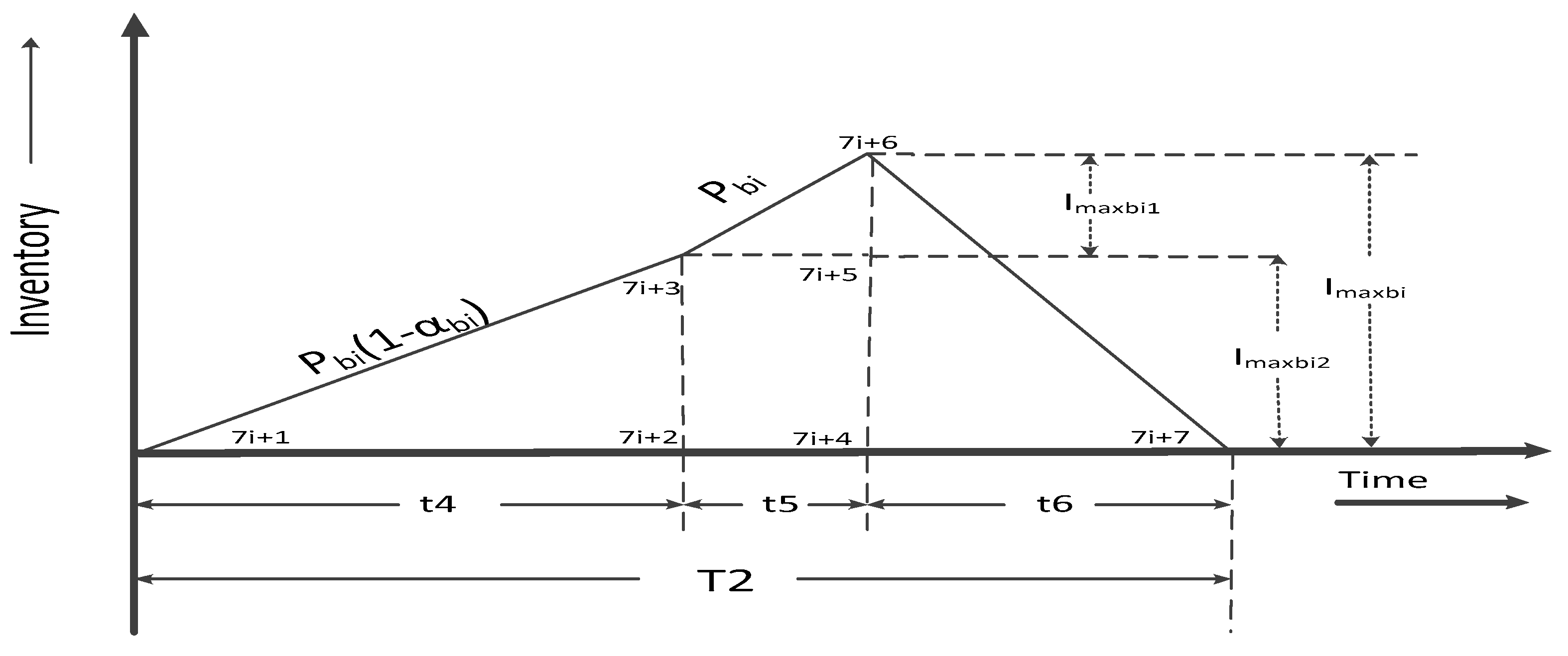
Appendix A.6. Inventory Diagram of the Last Phase of Manufacturer
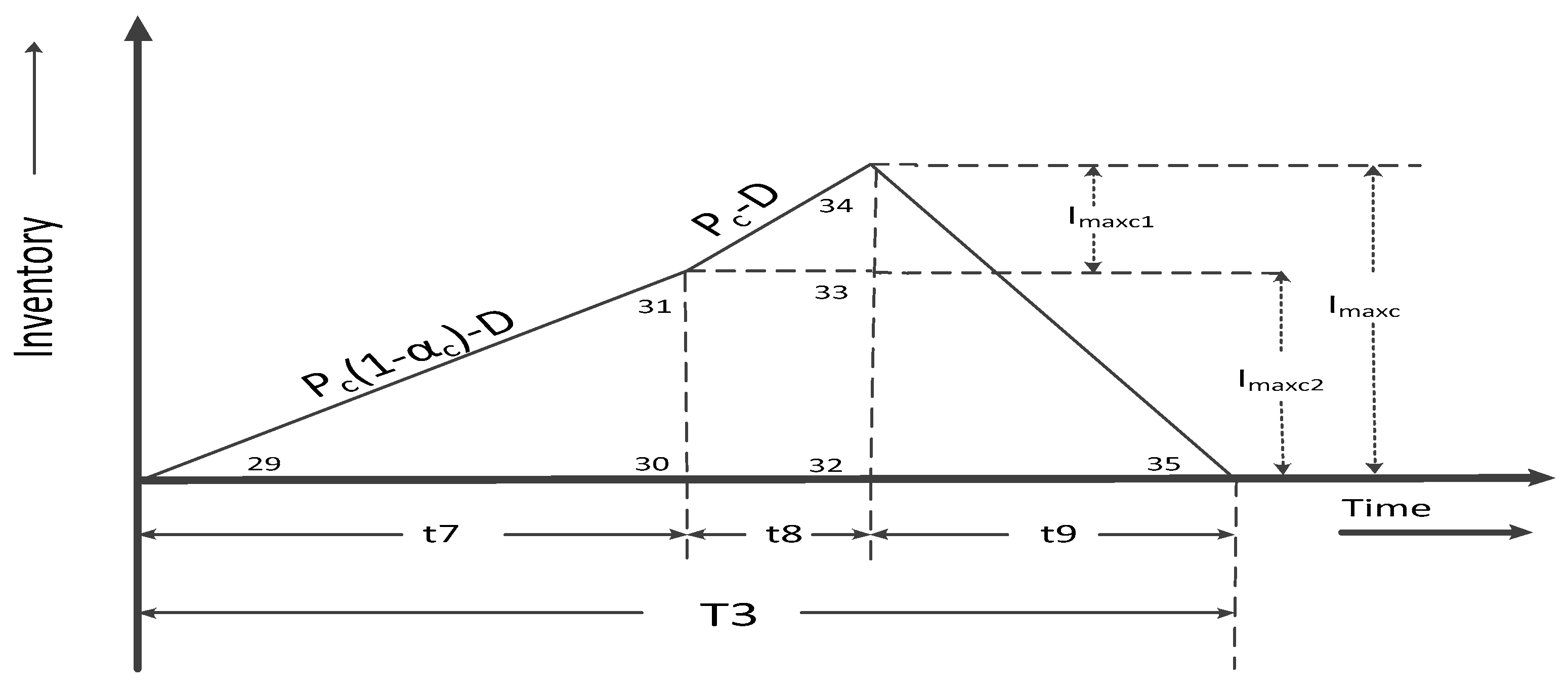
Appendix B
Appendix B.1. Mathematical Modeling
Appendix B.2. Phase A
References
- Kroes, J.R.; Ghosh, S. Outsourcing congruence with competitive priorities: Impact on supply chain and firm performance. J. Oper. Manag. 2010, 28, 124–143. [Google Scholar] [CrossRef]
- Bernard, K. The effect of outsourcing on supply chain performance at cadbury kenya limited. Int. J. Logist. Procure. Manag. 2019, 1, 123–138. [Google Scholar]
- Jilani, P.A. Indirect Procurement Strategies for Supply Chain Sustainability. Ph.D. Thesis, Walden University, Minneapolis, MN, USA, 2018. [Google Scholar]
- Hila, C.M.; Dumitraşcu, O. Outsourcing Within a Supply Chain Management Framework. In Proceedings of the 8th International Management Conference “Management Challenges for Sustainable Development”, Bucharest, Romania, 6–7 November 2014; pp. 328–336. [Google Scholar]
- Kroes, J.R. Outsourcing of Supply Chain Processes: Evaluating the Impact of Congruence between Outsourcing Drivers and Competitive Priorities on Performance. Ph.D. Thesis, Georgia Institute of Technology, Atlanta, GA, USA, 2007. [Google Scholar]
- Fill, C.; Visser, E. The outsourcing dilemma: A composite approach to the make or buy decision. Manag. Decis. 2000, 38, 43–50. [Google Scholar] [CrossRef]
- Mazlan, R.M.R.; Ali, K.N. Relationship between Supply Chain Management and Outsourcing. Ph.D. Thesis, Heriot-Watt University, Edinburgh, UK, 2005. [Google Scholar]
- Sana, S.S. A production-inventory model of imperfect quality products in a three-layer supply chain. Decis. Support Syst. 2011, 50, 539–547. [Google Scholar] [CrossRef]
- Rad, M.A.; Khoshalhan, F.; Glock, C. Optimizing inventory and sales decisions in a two-stage supply chain with imperfect production and backorders. Comput. Ind. Eng. 2014, 74, 219–227. [Google Scholar] [CrossRef]
- Sarkar, S.; Giri, B.J. Logistics. Stochastic supply chain model with imperfect production and controllable defective rate. Int. J. Syst. Sci. 2018, 7, 133–146. [Google Scholar]
- Nabernegg, S.; Bednar-Friedl, B.; Wagner, F.; Schinko, T.; Cofala, J.; Clement, Y.M. The Deployment of Low Carbon Technologies in Energy Intensive Industries: A Macroeconomic Analysis for Europe, China and India. Energies 2017, 10, 360. [Google Scholar] [CrossRef]
- Bian, J.; Zhao, X. Tax or subsidy? An analysis of environmental policies in supply chains with retail competition. Eur. J. Oper. Res. 2020, 283, 901–914. [Google Scholar] [CrossRef]
- Deng, J.; Luo, X.; Hu, M. Implications of a Carbon Tax Mechanism in Remanufacturing Outsourcing on Carbon Neutrality. Int. J. Environ. Res. Public Health 2022, 19, 5520. [Google Scholar] [CrossRef]
- Lankford, W.M.; Parsa, F. Outsourcing: A primer. Manag. Decis. 1999, 37, 310–316. [Google Scholar] [CrossRef]
- Franceschini, F.; Galetto, M.; Pignatelli, A.; Varetto, M.J. Outsourcing: Guidelines for a structured approach. Benchmarking Int. J. 2003, 10, 246–260. [Google Scholar] [CrossRef]
- Quinn, J.B.; Hilmer, F.G.J. Strategic outsourcing. MIT Sloan Manag. Rev. 1994, 35, 43. [Google Scholar]
- Hilletofth, P.; Hilmola, O.P.J. Role of logistics outsourcing on supply chain strategy and management. Strateg. Outsourcing Int. J. 2010, 3, 46–61. [Google Scholar] [CrossRef]
- Chiu, Y.-S.P.; Jhan, J.-H.; Chiu, V.; Chou, C.-L. Incorporating outsourcing, stochastic failure, and scrap into batch fabrication planning. Alex. Eng. J. 2020, 59, 5273–5284. [Google Scholar] [CrossRef]
- Kumar, M.; Vrat, P.; Shankar, R. A fuzzy goal programming approach for vendor selection problem in a supply chain. Comput. Ind. Eng. 2004, 46, 69–85. [Google Scholar] [CrossRef]
- Karamaşa, Ç.; Demir, E.; Memiş, S.; Korucuk, S. Weighting the factors affecting logistics outsourcing, Infinite Study. Decis. Mak. Appl. Manag. Eng. 2020, 4, 19–32. [Google Scholar] [CrossRef]
- Amid, A.; Ghodsypour, S.; O’Brien, C. A weighted additive fuzzy multiobjective model for the supplier selection problem under price breaks in a supply chain. Int. J. Product. Econ. 2009, 121, 323–332. [Google Scholar] [CrossRef]
- Rezaei, J.; Davoodi, M. A deterministic, multi-item inventory model with supplier selection and imperfect quality. Appl. Math. Model. 2008, 32, 2106–2116. [Google Scholar] [CrossRef]
- Karpak, B.; Kumcu, E.; Kasuganti, R.R. Purchasing materials in the supply chain: Managing a multi-objective task. Eur. J. Purch. Supply Manag. 2001, 7, 209–216. [Google Scholar] [CrossRef]
- Ji, Y.; Li, H.; Zhang, H.J. Risk-averse two-stage stochastic minimum cost consensus models with asymmetric adjustment cost. Group Decis. Negot. 2022, 31, 261–291. [Google Scholar] [CrossRef]
- Qu, S.; Shu, L.; Yao, J.J.C. Optimal pricing and service level in supply chain considering misreport behavior and fairness concern. Comput. Ind. Eng. 2022, 174, 108759. [Google Scholar] [CrossRef]
- Stević, Ž.; Karamaşa, Ç.; Demir, E.; Korucuk, S.J. Assessing sustainable production under circular economy context using a novel rough-fuzzy MCDM model: A case of the forestry industry in the Eastern Black Sea region. J. Enterp. Inf. Manag. 2021; ahead of print. [Google Scholar]
- Verma, V.; Bisht, P.; Joshi, S. Sustainable Supply chain Systems of Food and Beverages SMEs in developing countries: Theoretical perspective. J. Decis. Anal. Intell. Comput. 2022, 2, 36–52. [Google Scholar] [CrossRef]
- Tao, Z.; Guiffrida, A.L. Carbon Emission Modeling in a Two Stage Supply Chain. Am. J. Manag. 2017, 17, 82–92. [Google Scholar]
- Su, L.; Xiao, B.; Suo, C.; Yang, Y.J. Models for operation management under carbon policies—A review. Chem. Eng. Trans. 2016, 51, 1159–1164. [Google Scholar]
- Ameknassi, L.; Aït-Kadi, D.; Rezg, N.J. Integration of logistics outsourcing decisions in a green supply chain design: A stochastic multi-objective multi-period multi-product programming model. Int. J. Prod. Econ. 2016, 182, 165–184. [Google Scholar] [CrossRef]
- Zhang, Y.M.; Chen, W.D.; Mi, Y. Third-party remanufacturing mode selection for competitive closed-loop supply chain based on evolutionary game theory. J. Clean. Prod. 2020, 263, 121305. [Google Scholar] [CrossRef]
- Yan, W.; Li, H.Y.; Chai, J.W.; Qian, Z.F.; Chen, H. Owning or Outsourcing? Strategic Choice on Take-Back Operations for Third-Party Remanufacturing. Sustainability 2018, 10, 151. [Google Scholar] [CrossRef]
- He, P.; Zhang, W.; Xu, X.; Bian, Y.J. Production lot-sizing and carbon emissions under cap-and-trade and carbon tax regulations. J. Clean. Prod. 2015, 103, 241–248. [Google Scholar] [CrossRef]
- Van Hezewijk, L.; Dellaert, N.; Van Woensel, T.; Gademann, N.J. Using the proximal policy optimisation algorithm for solving the stochastic capacitated lot sizing problem. Int. J. Prod. Res. 2022, 22, 1–24. [Google Scholar] [CrossRef]
- Osintsev, N.; Rakhmangulov, A.; Baginova, V. Evaluation of logistic flows in green supply chains based on the combined DEMATEL-ANP method. Facta Univ. Ser. Mech. Eng. 2021, 19, 473–498. [Google Scholar] [CrossRef]
- Long, T.B.; Young, W.J.J.o.C.P. An exploration of intervention options to enhance the management of supply chain greenhouse gas emissions in the UK. J. Clean. Prod. 2016, 112, 1834–1848. [Google Scholar] [CrossRef]
- Xu, Z.; Elomri, A.; Pokharel, S.; Mutlu, F.J.S. The Design of Green Supply Chains under Carbon Policies: A Literature Review of Quantitative Models. Sustainability 2019, 11, 3094. [Google Scholar] [CrossRef]
- Setak, M.; Sharifi, S.; Alimohammadian, A. Supplier selection and order allocation models in supply chain management: A review. World Appl. Sci. J. 2012, 18, 55–72. [Google Scholar]
- Zhang, M.; Chen, J.; Chang, S.-H. An adaptive simulation analysis of reliability model for the system of supply chain based on partial differential equations. Alex. Eng. J. 2020, 59, 2401–2407. [Google Scholar] [CrossRef]
- Tempelmeier, H. A simple heuristic for dynamic order sizing and supplier selection with time-varying data. Prod. Oper. Manag. 2002, 11, 499–515. [Google Scholar] [CrossRef]
- Feng, C.-X.J.; Wang, J.; Wang, J.-S. An optimization model for concurrent selection of tolerances and suppliers. Comput. Ind. Eng. 2001, 40, 15–33. [Google Scholar] [CrossRef]
- Liu, C. Risk Prediction of Digital Transformation of Manufacturing Supply Chain Based on Principal Component Analysis and Backpropagation Artificial Neural Network. Alex. Eng. J. 2022, 61, 775–784. [Google Scholar] [CrossRef]
- Wiseman, Y. Autonomous Vehicles. In Encyclopedia of Information Science and Technology, 5th ed.; IGI Global: Hershey, PA, USA, 2020; Volume 1, pp. 1–11. Available online: https://u.cs.biu.ac.il/~wiseman/Autonomous-Vehicles-Encyclopedia.pdf (accessed on 19 October 2022).
- Figliozzi, M.A. Carbon emissions reductions in last mile and grocery deliveries utilizing air and ground autonomous vehicles. Transp. Res. Part D Transp. Environ. 2020, 85, 102443. [Google Scholar] [CrossRef]
- Liu, Z.; Wang, Y.; Feng, J.J.K. Vehicle-type strategies for manufacturer’s car sharing. Kybernetes, 2022; ahead-of-print. [Google Scholar] [CrossRef]
- Chen, Y.J. Research on collaborative innovation of key common technologies in new energy vehicle industry based on digital twin technology. Energy Rep. 2022, 8, 15399–15407. [Google Scholar] [CrossRef]
- Wang, L.; Zhao, H.; Liu, X.; Zhang, Z.; Xia, X.-H.; Evans, S.J. Optimal remanufacturing service resource allocation for generalized growth of retired mechanical products: Maximizing matching efficiency. IEEE Access 2021, 9, 89655–89674. [Google Scholar] [CrossRef]
- Guo, B.; Wang, Y.; Zhou, H.; Hu, F. Can environmental tax reform promote carbon abatement of resource-based cities? Evidence from a quasi-natural experiment in China. Environ. Sci. Pollut. Res. 2022, 1–13. [Google Scholar] [CrossRef]
- Chen, J.; Sun, C.; Wang, Y.; Liu, J.; Zhou, P.J. Carbon emission reduction policy with privatization in an oligopoly model. Environ. Sci. Pollut. Res. 2023, 1–22. [Google Scholar] [CrossRef]
- Zhang, S.; Zhou, Z.; Luo, R.; Zhao, R.; Xiao, Y.; Xu, Y.J. A low-carbon, fixed-tour scheduling problem with time windows in a time-dependent traffic environment. Int. J. Prod. Res. 2022, 1–20. [Google Scholar] [CrossRef]
- Yang, X.; Yang, X.; Teo, K.L. Huard type second-order converse duality for nonlinear programming. Appl. Math. Lett. 2005, 18, 205–208. [Google Scholar] [CrossRef]
- Peng, Y.; Ablanedo-Rosas, J.H.; Fu, P. A multiperiod supply chain network design considering carbon emissions. Math. Probl. Eng. 2016, 2016, 1581893. [Google Scholar] [CrossRef]
- Bao, X.-Y.; Zhang, L. Green procurement relationships development under carbon emissions regulations: A Bi-level programming approach. Int. J. Environ. Res. Public Health 2018, 15, 2183. [Google Scholar] [CrossRef]
- Jin, M.; Granda-Marulanda, N.A.; Down, I. The impact of carbon policies on supply chain design and logistics of a major retailer. J. Clean. Prod. 2014, 85, 453–461. [Google Scholar] [CrossRef]
- Coman, A.; Ronen, B. Production outsourcing: A linear programming model for the theory-of-constraints. Int. J. Prod. Res. 2000, 38, 1631–1639. [Google Scholar] [CrossRef]
- Qureshi, M.; Kumar, D.; Kumar, P. Modeling the logistics outsourcing relationship variables to enhance shippers’ productivity and competitiveness in logistical supply chain. Int. J. Product. Perform. Manag. 2007, 56, 689–714. [Google Scholar] [CrossRef]
- Li, J.; Su, Q.; Ma, L. Production and transportation outsourcing decisions in the supply chain under single and multiple carbon policies. J. Clean. Prod. 2017, 141, 1109–1122. [Google Scholar] [CrossRef]
- Benjaafar, S.; Li, Y.; Daskin, M.; Qi, L.; Kennedy, S. Low Carbon Logistics through Supply Chain Design and Coordination; United States, Department of Transportation, Research and Innovative Technology: Washington, DC, USA, 2010.
- Mashud, A.H.M.; Uddin, M.S.; Sana, S.S. A two-level trade-credit approach to an integrated price-sensitive inventory model with shortages. Int. J. Appl. Comput. Math. 2019, 5, 121. [Google Scholar] [CrossRef]
- Birgin, E.G.; Haeser, G.; Ramos, A. Augmented Lagrangians with constrained subproblems and convergence to second-order stationary points. Comput. Optim. Appl. 2018, 69, 51–75. [Google Scholar] [CrossRef]
- Mostafa, N.; Khajavi, M. Optimization of welding parameters for weld penetration in FCAW. J. Achiev. Mater. Manuf. Eng. 2006, 16, 132–138. [Google Scholar]
- Schittkowski, K. NLPQL: A FORTRAN subroutine solving constrained nonlinear programming problems. Ann. Oper. Res. 1986, 5, 485–500. [Google Scholar] [CrossRef]
- Sarkar, B.; Cárdenas-Barrón, L.E.; Sarkar, M.; Singgih, M.L. An economic production quantity model with random defective rate, rework process and backorders for a single stage production system. J. Manuf. Syst. 2014, 33, 423–435. [Google Scholar] [CrossRef]
- Sarkar, B. Supply Chain Coordination with Variable Backorder, Inspections, and Discount Policy for Fixed Lifetime Products. Math. Probl. Eng. 2016, 2016, 14. [Google Scholar] [CrossRef]
- Bazan, E.; Jaber, M.Y.; Zanoni, S.J. Carbon emissions and energy effects on a two-level manufacturer-retailer closed-loop supply chain model with remanufacturing subject to different coordination mechanisms. Int. J. Prod. Econ. 2017, 183, 394–408. [Google Scholar] [CrossRef]
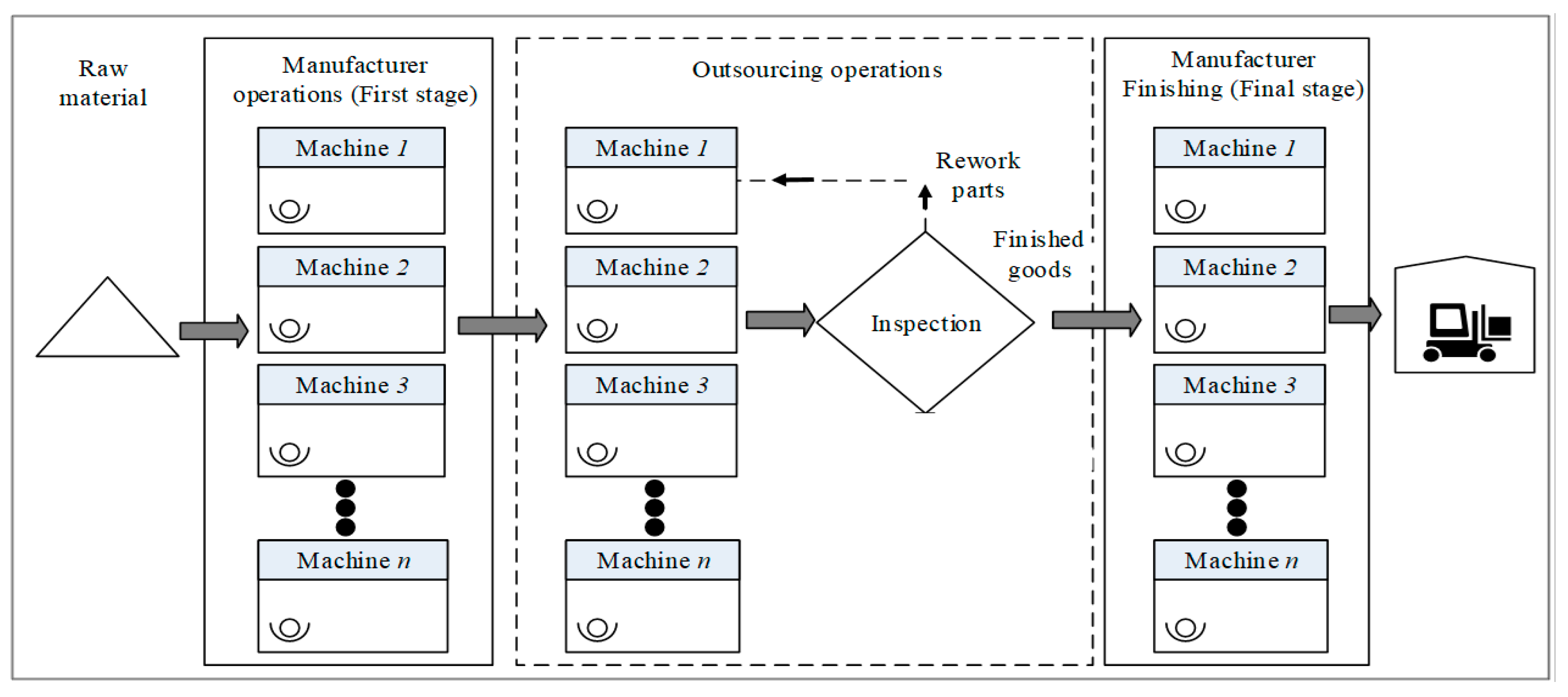

| Authors | Outsourcing | Supply Chain | Optimization | Methodology | Imperfection | Carbon Policy | |||||||
|---|---|---|---|---|---|---|---|---|---|---|---|---|---|
| Process | Product | Logistic | Centralized | Decentralize | NLP | LP and IP | SQP | Analytical | Carbon Tax | Carbon Cap | Carbon Trad | ||
| Yang et al. (2005) [51] | √ | √ | |||||||||||
| YangPeng (2016) [52] | √ | √ | √ | √ | |||||||||
| Xiao-Ying Bao (2018) [53] | √ | √ | √ | √ | √ | ||||||||
| Mingzhou Jin (2014) [54] | √ | √ | √ | √ | |||||||||
| Lhoussaine ameknassi (2016) [30] | √ | √ | √ | √ | √ | ||||||||
| Alex coman (2000) [55] | √ | √ | √ | ||||||||||
| M.N Qureshi, Dinesh Kumar (2007) [56] | √ | √ | √ | ||||||||||
| Jian Li, Qin Su (2017) [57] | √ | √ | √ | √ | √ | √ | √ | √ | |||||
| Saif benjaafar, Mark daskin (2010) [58] | √ | √ | √ | √ | √ | ||||||||
| Abolfazl Gharaei (2019) [59] | √ | √ | √ | √ | |||||||||
| Yuwan Shyi Peter Chiu et al. (2020) [60] | √ | √ | √ | √ | |||||||||
| Proposed Work | √ | √ | √ | √ | √ | √ | |||||||
| Notation | Description |
|---|---|
| M | Index for manufacturer |
| I | Index for outsourcers |
| J | Index for item |
| TCj | Total cost of the supply chain |
| TCmj | Total cost of manufacturer |
| TCoij | Total cost of ith outsourcer |
| HCmj | Holding cost of manufacturer |
| HCoij | Holding cost of outsourcer i |
| Hmj | Holding cost per unit item of manufacturer |
| Hoij | Holding cost per unit item of ith outsourcer |
| SCmj | Setup cost of manufacturer |
| SCoij | Setup cost of outsourcer i |
| Smj | Setup cost per unit item of manufacturer |
| Soij | Setup cost per unit item of ith outsourcer |
| PCmj | Production cost of manufacturer |
| PCoij | Production cost of outsourcer i |
| Maj | Production cost per unit item of Phase A for manufacturer |
| Mcj | Production cost per unit item of Phase C for manufacturer |
| Moi | Production cost per unit item of ith outsourcer |
| Dj | Constant rate of demand |
| Paj | Production rate of phase A |
| Pcj | Production rate of phase C |
| Pbij | Production rate of phase B for ith outsourcer |
| CEmj | Carbon emission cost for the manufacturer |
| CEoij | Carbon emission cost for outsourcer i |
| fmj | Carbon emission cost per ton CO2 emission for manufacturer |
| emj | Carbon emission per unit item production for the manufacturer |
| fbij | Carbon emission cost per ton CO2 emission for outsourcer i |
| ebij | Carbon emission per unit item production for outsourcer i |
| ftj | Carbon emission cost per ton CO2 emission in transportation |
| etmj | Carbon emission per unit item transportation of manufacturer |
| etoij | Carbon emission per unit item transportation of oustourcer i |
| αj | Rate of rework of phase A for the manufacturer |
| αcj | Rate of rework of phase C for manufacturer |
| αbij | Rate of rework for the ith outsourcer |
| MR | Marginal cost of outsourcers |
| Iaj | Inspection cost per unit item at phase A |
| Icj | Inspection cost per unit item at phase C |
| Ibij | Inspection cost per unit item at phase B for ith outsourcer |
| Fmj | Fixed transportation cost of manufacturer |
| Foij | Fixed transportaiotn cost of outsourcer i |
| Vmj | Variable transportation cost of manufacturer |
| Voij | Variable transportaion cost of outsourcer i |
| Manufacturer | Demand | Production Rate | Manufacturing Cost | Holding Cost | Setup Cost | Inspection Cost | Carbon Tax | CO2 Emission/Item | Defectives | Transportation Cost |
|---|---|---|---|---|---|---|---|---|---|---|
| Phase A | 300 | 600 | 12 | 50 | 50 | 10 | 23 | 0.8 | 0.05 | Fixed = 03 Variable = 15 CO2 Cost = 6 |
| Phase C | 300 | 400 | 8 | 50 | 9 | 23 | 0.02 |
| Phase B | Outsourcers | Production Rate | Manufacturing Cost | Holding Cost | Setup Cost | Rework Cost | Inspection Cost | Carbon Emission Cost | Defectives | CO2 Emission/Item | Transporation Cost |
| 1 | 450 | 6 | 56 | 45 | 6 | 9.5 | 23 | 0.04 | 0.18 | Fixed = 03 Variable = 15 CO2 Cost = 6 | |
| 2 | 550 | 7 | 50 | 50 | 7 | 10 | 23 | 0.04 | 0.2 | ||
| 3 | 580 | 8 | 47 | 55 | 8 | 10.5 | 23 | 0.04 | 0.22 |
| Manufacturer | Demand | Production Rate | Manufacturing Cost | Holding Cost | Setup Cost | Inspection Cost | Carbon Emission Cost | CO2 Emission/kg | Defectives | Transportation Cost |
|---|---|---|---|---|---|---|---|---|---|---|
| Phase A | 2,160,000 | 3,854,400 | 30 | 50 | 8 | 1.6 | 23 | 0.8 | 0.05 | Fixed = 03 Variable = 15 CO2 Cos t = 6 |
| Phase C | 2,160,000 | 3,854,400 | 30 | 50 | 1 | 23 | 0.02 |
| Phase B | Outsourcers | Production Rate | Manufacturing Cost | Holding Cost | Setup Cost | Rework Cost | Inspection Cost | Carbon Emission Cost | Defectives | CO2 Emission/Item | Transportation Cost |
| 1 | 450 | 6 | 80 | 15 | 6 | 1.2 | 23 | 0.04 | 0.18 | Fixed = 03 Variable = 15 CO2 Cost = 6 | |
| 2 | 550 | 7 | 50 | 10 | 7 | 1.2 | 23 | 0.04 | 0.2 | ||
| 3 | 580 | 8 | 40 | 5 | 8 | 1.2 | 23 | 0.04 | 0.22 |
| Case | Total Cost (TC) | Manufacturer Optimal Quantity (Q) | 1st Outsourcer Optimal Quantity (Qb1) | 2nd Outsourcer Optimal Quantity (Qb2) | 3rd Outsourcer Optimal Quantity (Qb3) |
|---|---|---|---|---|---|
| Case 1 | USD 93,362.8$ | 87.6 parts | 28.1 parts | 29.4 parts | 30.3 parts |
| Case 2 | SAR 350,233.46 | 1606.9 kg | 469.9 kg | 526.5 kg | 610.6 kg |
| Parameters | % Change in Values | Decision Variables | % Change in the Total Cost | |||
|---|---|---|---|---|---|---|
| Q | Qb1 | Qb2 | Qb3 | |||
| Sm | −50 | 50.4 | 15.5 | 16.8 | 17.9 | −0.3 |
| −25 | 51 | 15.7 | 17 | 18.1 | −0.15 | |
| 25 | 52.1 | 16 | 17.4 | 18.6 | 0.15 | |
| 50 | 52.7 | 16.2 | 17.6 | 18.8 | 0.3 | |
| Hm | −50 | 60.4 | 18.4 | 20.2 | 21.7 | −2 |
| −25 | 55.5 | 17 | 18.6 | 19.8 | −0.9 | |
| 25 | 48.4 | 14.9 | 16.2 | 17.2 | 0.9 | |
| 50 | 46.2 | 14.3 | 15.4 | 16.4 | 1.6 | |
| MR | −50 | 43.3 | 13.1 | 14.5 | 15.3 | −29.2 |
| −25 | 48.1 | 14.9 | 16.1 | 17.1 | −14.5 | |
| 25 | 54.1 | 16.7 | 18.1 | 17.3 | 14.5 | |
| 50 | 56.2 | 17.2 | 18.8 | 20.1 | 29 | |
| Ma | −50 | 51.6 | 15.9 | 17.2 | 18.4 | −4 |
| −25 | 51.6 | 15.9 | 17.2 | 18.4 | −2 | |
| 25 | 51.6 | 15.9 | 17.2 | 18.4 | 2 | |
| 50 | 51.6 | 15.9 | 17.2 | 18.4 | 3.9 | |
| Mc | −50 | 51.6 | 15.9 | 17.2 | 18.4 | −2.3 |
| −25 | 51.6 | 15.9 | 17.2 | 18.4 | 1.3 | |
| 25 | 51.6 | 15.9 | 17.2 | 18.4 | 1.3 | |
| 50 | 51.6 | 15.9 | 17.2 | 18.4 | 2.6 | |
| Ia | −50 | 51.6 | 15.9 | 17.2 | 18.4 | −3.2 |
| −25 | 51.6 | 15.9 | 17.2 | 18.4 | −1.6 | |
| 25 | 51.6 | 15.9 | 17.2 | 18.4 | 1.6 | |
| 50 | 51.6 | 15.9 | 17.2 | 18.4 | 3.2 | |
| Ic | −50 | 51.6 | 15.9 | 17.2 | 18.4 | −2.9 |
| −25 | 51.6 | 15.9 | 17.2 | 18.4 | −2.1 | |
| 25 | 51.6 | 15.9 | 17.2 | 18.4 | 1.4 | |
| 50 | 51.6 | 15.9 | 17.2 | 18.4 | 2.9 | |
| Parameters | % Change in Values | Decision Variables | % Change in the Total Cost | |||
|---|---|---|---|---|---|---|
| Q | Qb1 | Qb2 | Qb3 | |||
| Sb1 | −50 | 47.3 | 11.36 | 17.4 | 18.5 | −1.2 |
| −25 | 49.6 | 13.8 | 17.3 | 18.4 | −0.5 | |
| 25 | 53.3 | 17.7 | 17.2 | 18.3 | 0.4 | |
| 50 | 54.8 | 19.4 | 17.1 | 18.3 | 0.9 | |
| hb1 | −50 | 54 | 18.4 | 17.2 | 18.3 | −0.5 |
| −25 | 52.6 | 17 | 17.2 | 18.3 | −0.2 | |
| 25 | 50.7 | 14.9 | 17.3 | 18.4 | 0.2 | |
| 50 | 49.9 | 15.9 | 15.5 | 18.4 | 0.5 | |
| Mb1 | −50 | 51.6 | 15.9 | 17.2 | 18.4 | −2.3 |
| −25 | 51.6 | 15.9 | 17.2 | 18.4 | −1.1 | |
| 25 | 51.6 | 15.9 | 17.2 | 18.4 | 1.1 | |
| 50 | 51.6 | 15.9 | 17.2 | 18.4 | 2.3 | |
| Ib1 | −50 | 51.6 | 15.9 | 17.2 | 18.4 | −3.5 |
| −25 | 51.6 | 15.9 | 17.2 | 18.4 | −1.5 | |
| 25 | 51.6 | 15.9 | 17.2 | 18.4 | 1.5 | |
| 50 | 51.6 | 15.9 | 17.2 | 18.4 | 3.1 | |
| eb1 | −50 | 51.6 | 15.9 | 17.2 | 18.4 | −1.5 |
| −25 | 51.6 | 15.9 | 17.2 | 18.4 | −0.8 | |
| 25 | 51.6 | 15.9 | 17.2 | 18.4 | 1.0 | |
| 50 | 51.6 | 15.9 | 17.2 | 18.4 | 1.5 | |
Disclaimer/Publisher’s Note: The statements, opinions and data contained in all publications are solely those of the individual author(s) and contributor(s) and not of MDPI and/or the editor(s). MDPI and/or the editor(s) disclaim responsibility for any injury to people or property resulting from any ideas, methods, instructions or products referred to in the content. |
© 2023 by the authors. Licensee MDPI, Basel, Switzerland. This article is an open access article distributed under the terms and conditions of the Creative Commons Attribution (CC BY) license (https://creativecommons.org/licenses/by/4.0/).
Share and Cite
Alkahtani, M.; Hidri, L.; Mrad, M. Multi-Stage Production and Process Outsourcing in Automobile-Part Supply Chain Considering a Carbon Tax Strategy Using Sequential Quadratic Optimization Technique. Mathematics 2023, 11, 1191. https://doi.org/10.3390/math11051191
Alkahtani M, Hidri L, Mrad M. Multi-Stage Production and Process Outsourcing in Automobile-Part Supply Chain Considering a Carbon Tax Strategy Using Sequential Quadratic Optimization Technique. Mathematics. 2023; 11(5):1191. https://doi.org/10.3390/math11051191
Chicago/Turabian StyleAlkahtani, Mohammed, Lofti Hidri, and Mehdi Mrad. 2023. "Multi-Stage Production and Process Outsourcing in Automobile-Part Supply Chain Considering a Carbon Tax Strategy Using Sequential Quadratic Optimization Technique" Mathematics 11, no. 5: 1191. https://doi.org/10.3390/math11051191
APA StyleAlkahtani, M., Hidri, L., & Mrad, M. (2023). Multi-Stage Production and Process Outsourcing in Automobile-Part Supply Chain Considering a Carbon Tax Strategy Using Sequential Quadratic Optimization Technique. Mathematics, 11(5), 1191. https://doi.org/10.3390/math11051191





